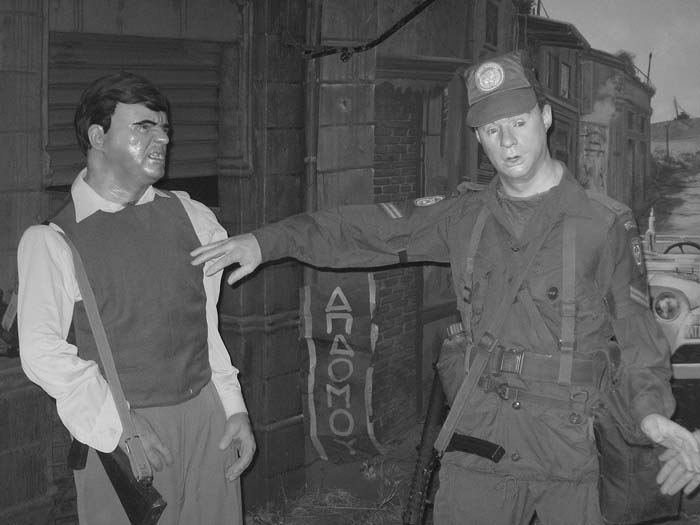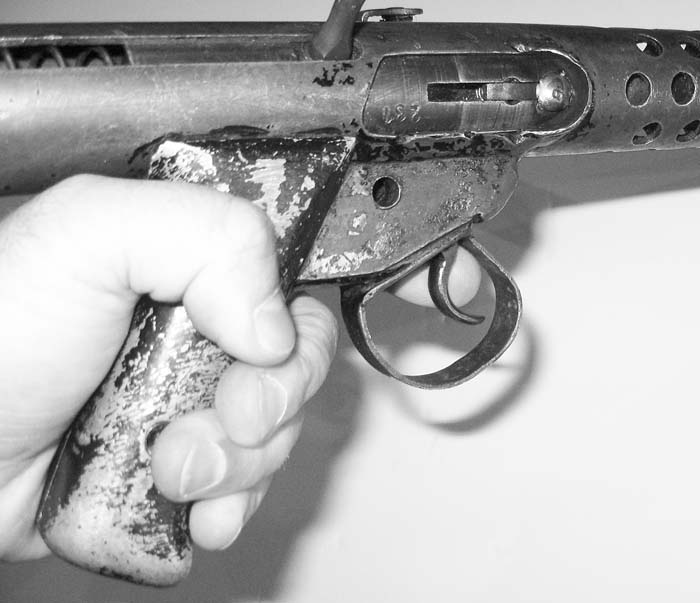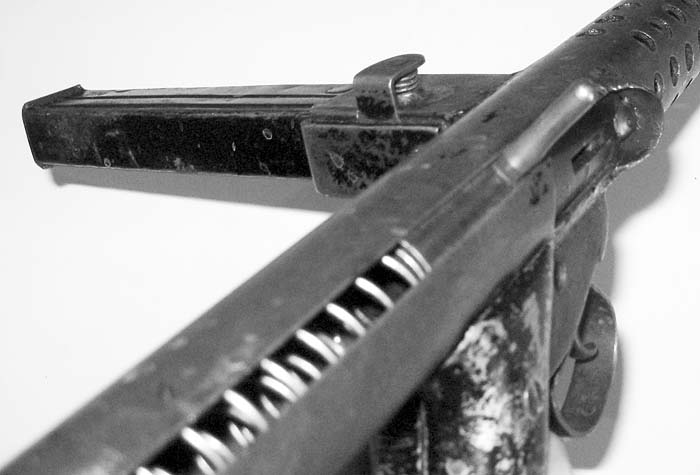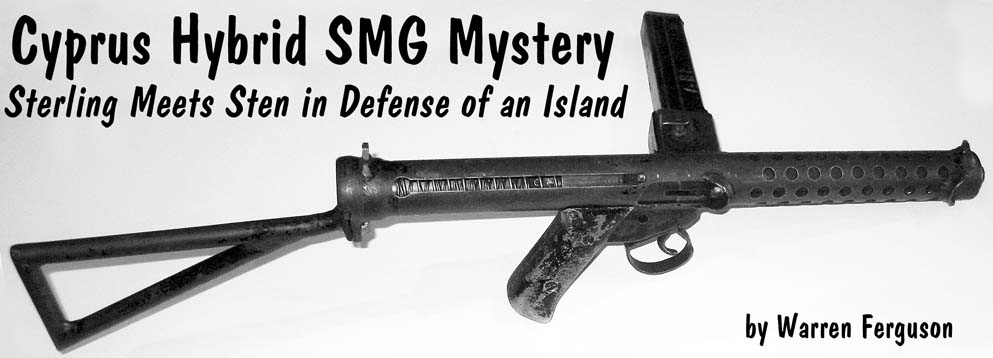The subgun features a non-folding stock and straight magazine.
By Warren Ferguson
Overlooking the bay that glistened with vivid blue Mediterranean water, the Canadian soldier knew that the beauty of the Cypriot island was tempered by the rage of Turkish and Greek soldiers, both of whom were known as fierce and determined warriors. Looking down to examine the small collection of confiscated firearms, the soldier noticed a 9mm submachine gun very similar to his issued Sterling. Oddly, it also had many features of the WWII British Sten. What exactly was this hybrid?
Cyprus, a visually idyllic island, has had a long history of trouble between the Greeks and Turks who both stake bold claims on the territory. The fighting hit a flashpoint in 1974 when Greek army officers of the Greek Cypriot National Guard staged a coup d’état against the president of Cyprus. They wished to unite Cyprus with Greece and Turkey’s response was to launch an amphibious invasion of Cyprus with 40,000 troops.
Canadian soldiers had been stationed in Cyprus from the early 1960s. Thus, they were well positioned to respond to the eruption of violence. Members of the Canadian Airborne Regiment, Canada’s UNFICYP (United Nations Peacekeeping Force in Cyprus) and others were at hand when the Turks pressed forth their stated objectives of protection of the Turkish minority to greater territorial acquisition by the taking of the Nicosia airport. Canadians physically kept the two sides apart, sometimes taking casualties.
The Greek and Turkish soldiers were one matter, but aggressive civilians were another. Added to the volatile mix was a divided population that owed its allegiance to one side or the other. Both were determined to maintain their stake on their particular corner of the island and their cultural pride. When the Canadians were not separating professional armies, they dealt with these armed civilian irregulars.

The Canadians were armed with FN-FALs and Sterling type 9mm submachine guns. The profile of the Sterling was well-known in these parts. United Nations peacekeepers had been carrying them since they arrived to buffer the two opposing sides. Also not unknown to the locals was the old WWII era Sten submachine gun as there were those who recalled their use by British troops and more than a few found their way into cellars.
What you had in the Sten was a simple blowback system in its rawest form. A tube contained a heavy fixed firing pin bolt that was locked by a sear to the rear until firing. Then, a strong spring propelled the bolt forward to strip a cartridge from the magazine, chamber it, and fire it in one motion.

The Sten was rather simple to field strip as well. It was designed that way, particularly the MKII, as a means of breaking it down as small as possible for concealment. The removable barrel came out from the front and the butt stock slid down and off the receiver tube when the user depressed a spring button. The Sterling was developed later and was a dramatic improvement. It was lighter, more compact, and imminently more reliable.
At a time of war, when tensions are high, how can irregulars obtain automatic weapons when the United Nations is doing its best to keep the warring sides apart and prevent a build up of arms? As evidenced by this odd 9mm creation, you simply take the best aspects of two well-known submachine guns, look for ways to make it as easy to manufacture as possible, and get the firearm in the hands of combatants. For a lack of a better name, this writer is going to call the submachine gun in this article a ‘Stenling.’

What is known is that sometime during his tour of duty, a Canadian soldier, likely from the Princess Patricia’s Canadian Light Infantry, came across the strangest looking Sterling he had ever seen. It has long been practice for the Canadian Forces to take samples of foreign weapons for regimental museums and training purposes, and then cut up and melt down the rest.

The prevailing wind out of National Defense HQ dictates that if there is no firearm present, hostility will cease. Naturally, history has proven this incorrect, but institutionally, the Canadian Forces is on board with United Nation mandated weapons decommissioning activities.
Subsequently, out of Cyprus came the Stenling via army sources and found its way into the Okanagan Military Museum in Kelowna, British Columbia. Not to be outdone by the Army, the Canadian Firearms Centre (think BATF bureaucracy) issued directives for the further DEWATing procedures for museum firearms. Thus, a full stripping and analysis of what could be a very rare Cypriot submachine gun was made impossible.
Looking closely at the Stenling it was easy to see that the Sterling played an important role in the submachine gun’s size, weight, overall layout and feel. The general outline of the trigger group was copied but the parts simplified. However, the two-piece pistol grip is made out of cast metal. The safety/selector was missing and so it is difficult to determine if it was a Sten or Sterling pattern, but an educated guess would be the latter.
The trigger guard is fixed and the distance from the trigger to pistol grip is noticeably increased, and does not add to the ergonomics of the firearm. Quite the opposite in fact and this detracts from an otherwise sensible package.
The cocking handle was near identical to a Sterling as is the perforated barrel shroud. Despite this, the muzzle area is welded and departs from the Sterling design because the barrel of the British firearm is fitted to the muzzle via two retaining screws. It does feature a hand protector forward of the ejection port.
From the Sten come the rudimentary sights and aspects of the magazine well assembly. The magazine is similar to the Sterling in construction, but straight and not curved. The magazine release button is like that of a Sten.
Gone is the familiar Sterling rear tube cap, as the design called for a Sten-like sliding spring retainer/butt stock. However, the simply constructed buttstock was made to look somewhat like that of the Sterling, but does not fold. It is made of bar steel and not stampings.
The Cypriot firearm is painted black and at twenty paces, the SMG appears to be a Sterling using a Sten magazine. So, how many were made? The bolt is numbered 281 but in times of trouble, serial numbers seldom start at zero often in order to exaggerate figures. So who exactly made it? This is a mystery.
In all, you have the most curious Sten/Sterling hybrid ever made. It is not uncommon for blowback submachine guns to be made in troubled spots. Nevertheless the Stenling shows both simplification and care and thought in its manufacture. This SMG could have been made cruder but was not. Yet all frills were cast aside. Perhaps the readership can shine some light on this curiosity. The chances are that this submachine gun – made quickly during a time of war – is one of very few constructed, if not one of a kind.
The author would like to thank OMM curator Keith Boehmer for providing the sample firearm.
| This article first appeared in Small Arms Review V11N10 (July 2008) |











